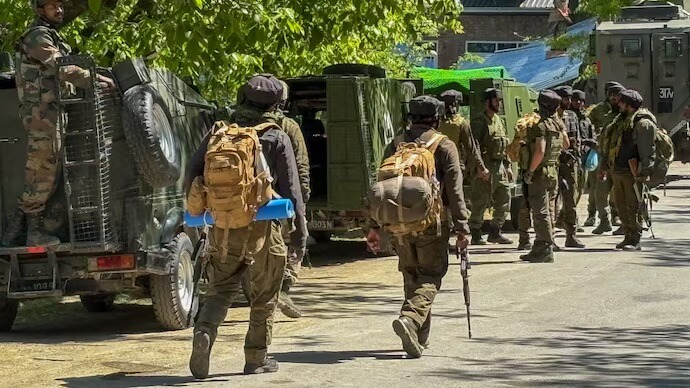By Naveed UI Hasan
India, which is predominantly Hindu, and Pakistan, which is predominantly Muslim, each control part of Kashmir, but claim the entire territory, and have fought three wars to conquer it.

Tensions between the two neighboring states have severely escalated since the terrorist attack in Pahalgam on April 22, 2025, in which more than 26 people were killed by gunmen who opened fire on tourists in Indian controlled Kashmir. Although Islamabad denied any involvement in the killings, India accused Pakistan of the attack and launched “Operation Sindoor” in the early hours of May 7, striking infrastructures in Pakistan, and in the Pakistan-administered territory of Jammu and Kashmir, with multiple missile attacks. Pakistan responded to the Indian attack with artillery fire and drone strikes targeting Indian sites. The clashes resulted in deaths and injuries among civilians and military personnel on both sides. Following intense international diplomatic engagement, India and Pakistan agreed, on May 10, to a ceasefire, halting further escalation.
But, even if temporary calm has returned, the events highlighted the urgency for sustained dialogue. Without addressing the core issues, such flare-ups may recur.
For nearly eight decades, India and Pakistan have experienced near-constant tensions. Indeed, the relationship between India and Pakistan has long been defined by moments of conflict, territorial disputes, and complex historical legacies. However, significant escalations such as the Pahalgam Incident have continued to shape and reshape the contours of their bilateral ties. The Pahalgam incidents, although lesser known in global media, marked a critical juncture in India-Pakistan relations.
This article examines the aftermath of the Pahalgam tensions and explores how it has influenced the trajectory of India-Pakistan relations, political narratives, and the broader security environment of South Asia. The events surrounding the Pahalgam incident present a vital case study of how the two nuclear-armed nations continue to grapple with security concerns, ideological differences, and diplomatic deadlock, while also offering potential pathways for conflict resolution and peacebuilding.
The Pahalgam incident refers to a significant clash that took place in the early months of 2025 in the disputed region of Kashmir. The episode arose when a confrontation occurred between Indian and Pakistani forces along the Line of Control (LoC) in Pahalgam. a sensitive area situated in the Indian-administered region of Jammu and Kashmir. The incident began with alleged cross-border firing between Indian and Pakistani forces, which rapidly escalated into direct military engagement. Both sides accused each other of violating ceasefire agreements and initiating the violence, leading to casualties on both sides. The episode brought to the forefront the perennial vulnerability of the LoC, where such skirmishes have the potential to escalate into larger, more destructive confrontations.
The Pahalgam tensions marked a new phase of heightened hostility between India and Pakistan, significantly altering the security and diplomatic dynamics between the two nations. It highlighted the precariousness of the Kashmir dispute, the volatility of the LoC, and the role of military and non-state actors in exacerbating tensions. The incident also revealed the inability of both countries to rely on existing peace-building mechanisms, such as Track II diplomacy or international pressure, which have thus far failed to ease tensions or foster lasting peace.
India’s response to the Pahalgam incident was swift and assertive. The government, led by Prime Minister Narendra Modi, framed the military confrontation as a direct challenge to India’s territorial integrity and sovereignty. In the aftermath of the skirmish, India reinforced its military presence along the LoC and issued stern warnings to Pakistan regarding its involvement in the violence. India’s nationalistic rhetoric amplified the tension, particularly in the context of an ongoing domestic political agenda where the government emphasized its commitment to securing its borders and fighting terrorism.
This hardline stance was not only designed to maintain domestic political support but also to send a clear message to Pakistan regarding India’s resolve to protect its national security at all costs. The domestic media played a pivotal role in shaping the national narrative, presenting the government as one that was unyielding in its stance against Pakistan, while portraying the incident as a direct consequence of Pakistan’s support for militant groups operating in Kashmir. The military’s narrative was supported by popular discourse, which took a hardline view, pushing for more assertive actions in dealing with Pakistani aggression.
In the wake of Pahalgam, India also renewed its call for the international community to acknowledge Pakistan’s role in fomenting violence through its alleged support of insurgency groups. India continued to lobby for Pakistan’s diplomatic isolation, pointing to the Kashmir issue as a source of continued instability in the region.
On the other side, Pakistan vehemently denied the allegations made by India regarding its role in the Pahalgam tensions. The Pakistani government, led by Prime Minister Imran Khan, dismissed the Indian claims as part of a broader propaganda campaign aimed at tarnishing Pakistan’s image in the international arena. Pakistan argued that the violence was an outcome of Indian provocations along the LoC and its attempts to consolidate control over Kashmir, particularly following India’s controversial move to revoke Jammu and Kashmir’s special status in 2019.
The Pakistani narrative emphasized India’s human rights violations in Kashmir, including alleged abuses of civilians under the guise of counterinsurgency operations. Pakistan sought to position itself as a defender of Kashmiri rights and highlighted the continuing oppression of Muslims in Indian-administered Kashmir. Pakistan’s reaction also included raising the issue at international forums, urging the United Nations and other global powers to intervene and pressurize India into returning to peaceful negotiations.
However, despite Pakistan’s diplomatic efforts, the international community was largely divided in its approach. While some countries expressed concerns about the escalation of violence, others maintained a cautious stance, wary of antagonizing either side. This lack of international consensus further complicated Pakistan’s diplomatic efforts to mitigate the tensions and bring the matter to the UN Security Council.
The Pahalgam tensions and their aftermath had significant geopolitical implications. South Asia, already considered one of the most volatile regions in the world, was once again in the global spotlight. The United States, which has traditionally maintained close ties with India, reiterated its support for India’s right to defend itself but also urged both sides to de-escalate and avoid further conflict. The US also expressed concern about the humanitarian situation in Kashmir, a region it has long considered a potential flashpoint for conflict.
China’s reaction to the crisis was cautious but significant. As a close ally of Pakistan, China reaffirmed its commitment to Pakistan’s security and sovereignty while calling for restraint and diplomatic dialogue. However, China also sought to ensure that the crisis did not derail its strategic interests in the region, particularly with respect to the China-Pakistan Economic Corridor (CPEC), which is seen as a cornerstone of Sino-Pakistani cooperation.
Russia, similarly, adopted a diplomatic approach, advocating for a peaceful resolution through dialogue and diplomacy. However, Russia’s stance was more nuanced, recognizing the complexities of the Kashmir dispute and expressing concern over the potential for broader regional instability. These international reactions underscored the broader global interest in maintaining peace between India and Pakistan, especially given their nuclear capabilities and the potential for a regional conflict to escalate into a global crisis.
In the wake of the Pahalgam tensions, the future of India-Pakistan relations remains uncertain. The key factors that will shape the future trajectory of their relationship include the willingness of both governments to engage in sustained dialogue, the role of international actors, and the presence of domestic pressures on both sides.
The potential for peace between India and Pakistan will require the establishment of trust-building measures that address the root causes of the conflict, namely the Kashmir dispute and cross-border terrorism. While sporadic ceasefire agreements, such as the one in 2021, have shown that limited cooperation is possible, lasting peace will require political will from both sides to de-escalate and engage in meaningful talks. A comprehensive peace framework should consider not only the territorial dispute but also broader issues such as trade, water sharing, and regional connectivity.
The role of the international community remains crucial in facilitating a dialogue that could pave the way for long-term peace. However, international pressure must be balanced with respect for both nations’ sovereignty and self-determination. Third-party mediation, particularly from the UN or regional powers, could play a critical role in ensuring that tensions do not escalate further and that a dialogue process is established.
Ultimately, Pahalgam will likely be remembered as a key moment in the evolving India-Pakistan relationship. The possibility of sustained peace is real, but it will require both nations to set aside their deep-rooted mistrust, nationalistic rhetoric, and militaristic posturing. Only through diplomatic engagement and efforts to address the underlying issues will the two countries be able to build a future of stability and cooperation in South Asia.
The Pahalgam tensions have once again demonstrated the fragility of India-Pakistan relations and the ever-present threat of conflict in the region. While the immediate aftermath of the incident may have appeared as another routine flare-up in a history defined by violence, it also represented an opportunity for introspection and recalibration of policies.
For India and Pakistan, the road to peace is long and fraught with challenges, but it is not beyond reach. What is essential moving forward is the commitment to engage in dialogue, both bilaterally and through the support of the international community, and to explore cooperative avenues that prioritize regional stability over nationalistic agendas. The future of South Asia rests on the ability of both nations to chart a course that avoids war and embraces peace, stability, and prosperity for all.
Author: Naveed UI Hasan – PhD Scholar (International Relations). He is a Visiting lecturer at Karakoram International University. His research primarily investigates the strategic relations between Pakistan, China, India, and the USA. Additionally, his scholarly interests encompass a wide range of topics within South Asian studies, including extremism, radicalization, terrorism, the foreign policies of major global powers, and regional issues.
(The opinions expressed in this article are solely those of the author and do not necessarily reflect the views of World Geostrategic Insights).
Image Credit: PTI







